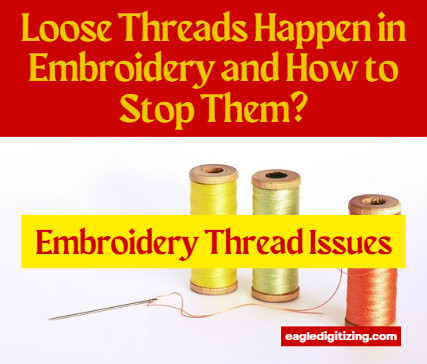Why Do Loose Threads Happen in Embroidery and How to Stop Them?
Have you ever found yourself delicately stitching away, only to be frustrated by the appearance of loose threads? How do these pesky strands infiltrate our carefully crafted stitches? In this article, we'll delve into the intricate world of embroidery to uncover the causes of loose threads and reveal effective strategies to prevent them. From tension woes to needle mishaps and fabric fiascos, we'll explore every aspect of this embroidery conundrum and equip you with the tools to stitch with confidence.
Tension
issues
Embroidery is a delicate balance of tension, where the slightest imbalance can lead to loose threads wreaking havoc on your masterpiece.
- Upper thread tension
The tension of the
upper thread must be just right – not too tight, lest it cause puckering, and
not too loose, which invites the dreaded loose threads to the party.
- Bobbin tension
Ah, the elusive bobbin tension – often overlooked but crucial in maintaining harmony in the embroidery realm. Incorrect bobbin tension can result in loops and knots, contributing to the chaos of loose threads.
Needle-related
factors
The needle, a humble yet mighty tool, plays a significant role in the occurrence of loose threads.
- Incorrect needle size
Selecting the wrong
needle size is akin to using a sledgehammer to crack a nut – it may get the job
done, but not without causing collateral damage. A needle too large can create
unsightly holes and loose threads, while one too small struggles to penetrate
the fabric, leading to frustration.
- Dull or damaged needle
A dull or damaged needle is the nemesis of smooth stitching. It snags and tugs at the fabric, creating irregular stitches and inviting loose threads to join the fray. Regular needle maintenance is key to preventing this embroidery nightmare.
Fabric
choice and preparation
The fabric sets the stage for the embroidery performance, and its choice and preparation can influence the appearance of loose threads.
- Fabric type
Not all fabrics are
created equal – some are more prone to loose threads than others. Fabrics with
loose weaves or stretchy fibers are particularly notorious for causing trouble.
Choose wisely to avoid a tangled mess of loose threads.
- Fabric stretching and stabilizing
Properly preparing the fabric is essential in preventing loose threads. Stretching it tautly in the hoop and using stabilizers provide a solid foundation for your stitches, minimizing the risk of loose threads.
Proper
tension adjustment
Achieving the perfect tension is the holy grail of embroidery, and it begins with proper tension adjustment.
- Testing tension before starting
Before diving into
your embroidery project, take a moment to test the tension on a scrap piece of
fabric. Adjust the tension settings until you find the sweet spot where loose
threads dare not venture.
- Adjusting upper and bobbin tension
Fine-tune the tension settings on your embroidery machine to ensure both the upper and bobbin threads are in sync. A harmonious balance is the key to warding off loose threads.
Needle
selection and maintenance
The needle may be small, but its impact on embroidery is mighty. Choosing the right needle and keeping it in top condition can prevent loose threads from crashing your stitching party.
- Choosing the right needle size
Match the needle
size to the fabric weight and embroidery thread for smooth stitching and
minimal loose threads. A well-chosen needle is your first line of defense
against embroidery woes.
- Regularly replacing needles
Don't let a dull or damaged needle sabotage your embroidery endeavors. Keep a stash of fresh needles on hand and replace them regularly to ensure clean, crisp stitches and banish loose threads for good.
Fabric
considerations
Give your fabric some love and attention to keep loose threads at bay.
- Pre-washing fabric
Pre-wash your
fabric to remove any sizing or residues that could cause it to shrink or
distort during embroidery. A clean, stable fabric is less likely to produce
loose threads.
- Using stabilizers
Stabilizers are the unsung heroes of embroidery, providing support and structure to your stitches. Choose the right stabilizer for your fabric and design to minimize the risk of loose threads and ensure smooth, even stitching.
Slow and
steady stitching
In the fast-paced world of embroidery, slow and steady wins the race – and prevents loose threads from derailing your progress.
- Avoiding rapid movement
Don't rush through
your embroidery project. Slow down the stitching speed to maintain control and
precision, minimizing the risk of loose threads and ensuring a flawless finish.
- Monitoring stitch quality
Keep a close eye on the quality of your stitches as you embroider. If you notice any signs of loose threads or irregularities, pause and make any necessary adjustments to prevent further issues.
Securing
thread ends
Don't let loose threads run amok – take control by securing them properly.
- Backstitching at the beginning and end
Anchor your threads
with backstitches at the beginning and end of each design to prevent them from
coming loose during handling or washing. A secure start and finish ensure loose
threads have no chance to unravel your hard work.
- Using thread knots or tacking stitches
For extra security, tie off your threads with knots or use tacking stitches to keep them in place. These small but mighty techniques can make all the difference in preventing loose threads and maintaining stitch integrity.
Handling
intricate designs
Embroidery is an art form, and intricate designs are its pièce de résistance. Handle them with care to avoid loose thread mishaps.
- Breaking down complex designs
Divide complex
designs into manageable sections to avoid overwhelming yourself – and your
embroidery machine. By taking it one stitch at a time, you can minimize the
risk of loose threads and ensure smooth stitching from start to finish.
- Using embroidery software for optimization
Take advantage of embroidery software to optimize your design placement and sequencing. By minimizing thread jumps and reducing unnecessary stops and starts, you can streamline the embroidery process and keep loose threads at bay.
Troubleshooting Loose Threads
Identifying
tension issues
When it comes to loose threads, tension is often the culprit. But fear not – identifying and addressing tension issues is easier than you might think.
- Examining stitch quality
Take a close look
at the quality of your stitches. Are they even and consistent, or do you notice
any signs of tension issues such as loops or puckering? Examining stitch
quality is the first step in troubleshooting loose threads.
- Testing tension adjustments
If you suspect tension issues, don't panic. Experiment with adjusting the tension settings on your embroidery machine to find the perfect balance. With a little trial and error, you can banish loose threads and achieve flawless stitching.
Checking
needle condition
A dull or damaged needle can wreak havoc on your embroidery project, leading to loose threads and frustration. But fear not – checking and replacing your needle is a simple yet effective solution.
- Inspecting needle for damage
Take a close look
at the tip of your needle. Do you see any signs of wear, such as burrs or
bends? If so, it's time to replace your needle and bid farewell to loose
threads for good.
- Replacing needle if necessary
Don't wait until it's too late – replace your needle at the first sign of damage to prevent further issues. With a sharp, properly maintained needle, you can enjoy smooth stitching and say goodbye to loose threads once and for all.
Assessing
fabric compatibility
Not all fabrics are created equal, and some are more prone to producing loose threads than others. But fear not – with a little experimentation and expert advice, you can find the perfect fabric for your embroidery projects.
- Experimenting with different fabrics
Take some time to
experiment with different fabric types to find the perfect match for your
embroidery designs. By exploring your options and learning from each
experience, you can minimize the risk of loose threads and achieve stunning
results.
- Consulting embroidery experts for advice
When in doubt, don't hesitate to seek advice from embroidery experts. Whether online or in person, embroidery professionals can offer valuable insights and recommendations to help you choose the right fabric for your projects and prevent loose threads from spoiling your stitching fun.
In conclusion, loose threads in embroidery are
a common frustration, but with the right knowledge and techniques, they can be
easily prevented. By understanding the causes of loose threads and implementing
preventive measures, you can enjoy smooth, flawless stitching and create
stunning embroidery projects with confidence. So fear not, dear embroiderer –
armed with the tips and tricks shared in this guide, you can banish loose
threads from your stitching repertoire and unleash your creativity with ease.



